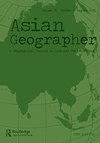Summer climate implications of tree-ring latewood width: a case study of Tsuga longibracteata in South China
IF 2.2
Q2 GEOGRAPHY
引用次数: 11
Abstract
ABSTRACT Summer climate variability in South China at decadal scales is not well understood due to the relatively short meteorological records and the scarcity of paleo-proxies. Herein, we explore the potential of using tree-ring latewood width (LWW) from Tsuga longibracteata to reconstruct summer climatic factors. Latewood usually forms in the mid- to late growing season, at least partly during summer. Tree-ring samples were collected at three sites (HS, QSZ, and SJD) close to the northern boundary of Guangxi province. We built three LWW chronologies and three adjusted LWW chronologies (LWWadj) after the removal of the influence of earlywood on latewood growth. Bootstrapped correlation and response analyses indicate that the LWW chronologies are significantly correlated with summer climatic factors, and the LWWadj chronologies show much higher correlations. The extent to which summer climatic signals can be extracted from LWWadj is site-dependent. At the well-drained sites (QSZ and SJD) with abundant sunshine, LWWadj shows significant positive correlations with July–August Standardised Precipitation-Evapotranspiration Index (SPEI), owing to the positive response to precipitation and the negative response to temperature. In contrast, LWWadj only exhibits positive responses to July temperature on north-oriented slope (HS) with high water-holding capacity. Nearly 37% of the variance in the regional SPEI can be explained by the LWWadj chronology from the forest stand (QSZ) on well-drained southeast-facing slope with less endogenous disturbances. These results indicate that there is a great potential of using LWWadj to reconstruct summer SPEI in South China when suitable sampling sites are selected.树轮晚木宽度对夏季气候的影响——以华南长苞杉木为例
由于相对较短的气象记录和缺乏古代用物,中国南方夏季气候在年代用尺度上的变化尚未得到很好的理解。本文探讨了利用长苞杉树轮晚木宽度(LWW)重建夏季气候因子的潜力。晚木通常在生长季节的中后期形成,至少部分在夏季形成。在靠近广西北部边界的HS、QSZ和SJD 3个站点采集了树木年轮样本。在排除了早木对晚木生长的影响后,我们建立了3个LWW年表和3个调整后的LWW年表(LWWadj)。自举相关和响应分析表明,LWW年代学与夏季气候因子具有显著的相关关系,其中LWWadj年代学表现出更高的相关性。从LWWadj中提取夏季气候信号的程度取决于地点。在日照充足、排水良好的地点(QSZ和SJD), LWWadj与7 - 8月标准化降水蒸散发指数(SPEI)呈显著正相关,表现为对降水的正响应和对温度的负响应。相比之下,LWWadj仅在持水量较大的北向坡面对7月气温有正响应。近37%的区域SPEI变化可以用排水良好的东南坡林分(QSZ)的LWWadj年代学来解释,内源干扰较小。这些结果表明,如果选择合适的采样点,利用LWWadj重建华南夏季SPEI具有很大的潜力。
本文章由计算机程序翻译,如有差异,请以英文原文为准。
求助全文
约1分钟内获得全文
求助全文
来源期刊

Asian Geographer
GEOGRAPHY-
CiteScore
3.30
自引率
0.00%
发文量
7
期刊介绍:
Asian Geographer disseminates knowledge about geographical problems and issues focusing on Asia and the Pacific Rim. Papers dealing with other regions should have a linkage to Asia and the Pacific Rim. Original and timely articles dealing with any field of physical or human geographical inquiries and methodologies will be considered for publication. We welcome, for example, submissions on people-environment interactions, urban and regional development, transport and large infrastructure, migration, natural disasters and their management, environment and energy issues. While the focus of the journal is placed on original research articles, review papers as well as viewpoints and research notes under the category of “Asian Geography in Brief” are also considered. Review papers should critically and constructively analyse the current state of understanding on geographical and planning topics in Asia. The ‘Asian Geography in Brief’ section welcomes submissions of applied geographical and planning research about Asia. The section aims to showcase (1) the diverse geography and planning of Asia; and (2) the diverse geographical and planning research about Asia. The journal will also publish special issues on particular themes or areas. Book reviews can be included from time to time.
 求助内容:
求助内容: 应助结果提醒方式:
应助结果提醒方式:


